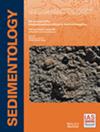海平面上升过程中山谷封闭三角洲的自生演化:数值和物理建模的启示
IF 2.8
2区 地球科学
Q1 GEOLOGY
引用次数: 0
摘要
近岸切谷是将沉积物、养分、污染物和有机碳从大陆输送到海洋的重要通道。因此,了解切谷内三角洲的自生演化以及这种演化如何受到海平面相对上升的影响至关重要。迄今为止,关于受切入谷或其他形式的先行地形限制的三角洲如何应对海平面上升的研究还很有限。现有的自地层理论设想,在相对海平面上升和沉积物供应速率不变的情况下,二维或非封闭三维扇三角洲可经历三个演化阶段:渐进、自断裂和自断裂后的横断。在这项研究中,我们对几何数值模型和物理实验进行了综合研究,以探讨在相对海平面上升率和沉积物供应量恒定的条件下,各种切谷几何形状的三角洲的自断裂演化过程。研究结果表明,先行地形(河谷几何形状)和沉积物质量平衡在三角洲几何形状中的体现,会导致三角洲海岸线动态和河流冲刷频率的自生变化。主要发现如下(i) 与矩形和梯形横截面的山谷相比,三角形横截面的山谷中的三角洲在海平面上升的情况下,往往会经历更快的前倾、自冲和自冲后的横断,并表现出更突出的凸向海岸线轨迹。(ii) 海岸线轨迹还与三角洲顶坡的几何形状有关,在顶坡坡度减小的情况下,海岸线轨迹变得更加凸向。(iii) 即使海平面相对上升的速度相同,不同几何形状的山谷在海平面上升时三角洲上的河流冲刷频率也明显不同;这是由于不同山谷几何形状的海岸线迁移的时间演化不同,以及由此导致的三角洲顶斜坡倾斜的不同造成的。这项研究凸显了沉积系统在不同地形构造限制下反应的复杂性,而迄今为止,序列-地层模型在很大程度上忽视了这一点。研究结果有助于了解封闭三角洲未来的海岸线行为和河流冲刷危险,也有助于解码地层记录。本文章由计算机程序翻译,如有差异,请以英文原文为准。
Autogenic evolution of valley-confined deltas during sea-level rise: Insights from numerical and physical modelling
Nearshore incised valleys are important conduits for the transport of sediment, nutrients, pollutants and organic carbon from the continents to the sea. Therefore, it is essential to understand the autogenic evolution of deltas confined within incised valleys and how such evolution is affected by relative sea-level rise. To date, limited research has focused on how deltas constrained by incised valleys or other forms of antecedent topography respond to rising sea level. An existing theory of autostratigraphy envisages scenarios in which two-dimensional or unconfined three-dimensional fan deltas can experience three evolutionary stages under constant rates of relative sea-level rise and sediment supply: progradation, autoretreat and post-autobreak transgression. In this work, an integrated study of geometric numerical models and physical experiments is undertaken to investigate autostratigraphic delta evolution for a variety of incised-valley geometries, under conditions of constant rates of relative sea-level rise and sediment supply. Results indicate that interplays of antecedent topography (valley geometries) and sediment mass balance expressed in resultant deltaic geometries can result in autogenic changes in shoreline dynamics and river avulsion frequency on deltas. The following primary findings arise. (i) Compared to valleys with rectangular and trapezoidal cross-sectional profiles, valleys with triangular cross-sections tend to contain deltas that experience faster rates of progradation, autoretreat and post-autobreak transgression under rising sea level, and exhibit a more prominent convex-seaward shoreline trajectory. (ii) The shoreline trajectory is also related to delta topset geometry, becoming more convex-seaward under decreasing topset slopes. (iii) River avulsion frequency on deltas with rising sea level varies markedly across valleys with different geometries, even under the same rate of relative sea-level rise; this is attributed to the difference in temporal evolution of shoreline migration for different valley geometries and the resultant difference in the delta topset aggradation. This study highlights complexities in responses of sedimentary systems under the confinement of different topographic configurations that have hitherto largely been overlooked in sequence-stratigraphic models. The findings provide insight into future shoreline behaviour and river avulsion hazard on confined deltas, and for decoding the stratigraphic record.
求助全文
通过发布文献求助,成功后即可免费获取论文全文。
去求助
来源期刊

Sedimentology
地学-地质学
CiteScore
8.20
自引率
11.40%
发文量
94
审稿时长
6-12 weeks
期刊介绍:
The international leader in its field, Sedimentology publishes ground-breaking research from across the spectrum of sedimentology, sedimentary geology and sedimentary geochemistry.
Areas covered include: experimental and theoretical grain transport; sediment fluxes; modern and ancient sedimentary environments; sequence stratigraphy sediment-organism interaction; palaeosoils; diagenesis; stable isotope geochemistry; environmental sedimentology
 求助内容:
求助内容: 应助结果提醒方式:
应助结果提醒方式:


